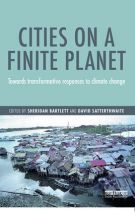Cities on a Finite Planet: Towards transformative responses to climate change

Cities on a Finite Planet builds upon and goes beyond the Inter-governmental Panel on Climate Change (IPCC) Fifth Assessment Report (AR5) chapter on urban areas. Written by the same team, this book is one of the first bridges between AR5 and the IPCC’s sixth assessment cycle (AR6). Thus it provides useful reading for both professionals and practitioners working in urban development, as well as general lay people with an interest in these issues.
The book was borne out of one of the IPCC team meetings in Bled in 2013, which acknowledged that the AR5’s chapter on urban areas needed expanding in relation to policy potential and transformative action for adaptation and mitigation at city and municipal levels. As such, Cities on a Finite Planet “explores the ways that cities can address their local needs around climate adaptation, as well as development and disaster risk reduction, while at the same time contributing to the global goals of climate change mitigation” (page xx).
Written by 37 contributors, including the editors Bartlett and Satterthwaite, this book comprises 13 chapters. The first two chapters set the scene and context for the book. Satterthwaite and Bartlett in Chapter 1 introduce cities, their growing importance, and their mention in the UN Framework Convention on Climate Change and the Sustainable Development Goals (SDGs). Following on, Fraser, Pelling and Solecki provide a conceptual foundation in Chapter 2 for analysing urban risk associated with disasters and climate change. In particular, they unpack conceptual terms of risk, vulnerability, resilience, transformation and development, and discuss risk reduction pathways and the agency of urban actors using these conceptual lenses (page 17).
Forming the core of this book, Chapters 3 to 11 each represent one city case study. They examine how local needs and climate change issues are being addressed, in particular through four local agendas: human development, disaster risk reduction, climate change adaptation, and climate mitigation (page 200). These chapters also look at how scientific information about climate change can be translated into local action. Drawing upon expert and in-depth knowledge, the nine city case studies illustrate the importance of city government and highlight the significance of getting it right in cities to address global concerns. The city case studies are: Bangalore, India; Bangkok, Thailand; Dar es Salaam, Tanzania; Durban, South Africa; London, UK; Manizales, Colombia; Mexico City, Mexico; New York, USA; and Rosario, Argentina. Thus each global region is represented at least once.
To draw out the lessons from the diverse and rich city analyses of climate change adaptation and mitigation in the preceding nine chapters, Chapter 12 gives a cross-city analysis. Acknowledging that each city is unique, the critical assessment highlights that in every city the intensity and frequency of extreme events has increased (page 203). After a summary of changes in climate and climate-related risks in each of the cities, Chapter 12 examines the coordination issues within complex webs of relationships and governance. It then proceeds to review the nine case studies through the four local agendas identified above, and concludes by considering the synergies between these agendas. It identifies what constrains the international process from meeting the SDGs, and considers how local action can address global goals through civil society, partnerships with local government, local data, knowledge bases built on urban areas, and connection between international and local plans. To close, the chapter reminds us that transformative adaptation unites development with climate change adaptation and mitigation, and that city and municipal governments need to work with their populations for the common good of present and future generations (pages 259–260).
Book note prepared by Hannah Keren Lee
Search the Book notes database
Our Book notes database contains details and summaries of all the publications included in Book notes since 1993 - with details on how to obtain/download.
Use the search form above, or visit the Book notes landing page for more options and latest content.
For a searchable database for papers in Environment and Urbanization, go to http://eau.sagepub.com/

